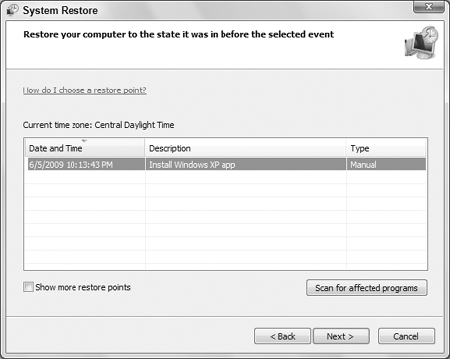2. Creating a restore point
System Restore is the component of System Protection
that protects your important system files — the ones Windows 7 needs to
work correctly. System Restore automatically creates a restore point
daily. It also creates a restore point when it detects that you're
about to do something that changes system files. But you can also
create your own restore points. This might be a good idea when you're
about to install some older hardware or software that wasn't
specifically designed for Windows 7. It's certainly not required, but
it's a smart and safe thing to do.
To create a restore point, get to the System Protection tab shown back in Figure 1
and click the Create button. When prompted, you can type in a brief
description as to why you manually created the restore point. Perhaps
"Pre-Acme Widget install" if you're about to install an Acme widget.
Then click Create and OK.
Next you install your Acme Widget or whatever. Take
it for a spin, make sure it works. If it works fine and you don't
notice any adverse effects, great. You can forget about the restore
point and go on your merry way.
If it turns out that change you made wasn't such a
great idea after all, first you have to uninstall it. That's true
whether it's hardware or software.
After you've uninstalled the bad device or program,
you can make sure no remnants of it lag behind by returning to the
restore point you specifically set up for that program or device.
If you install other programs or devices after the
bad one, don't skip over other restore points to the one you created
for the new item. If you do, you'll also undo the good changes made by
the good programs and devices, which will likely make those stop
working! You have to be methodical about these things. Set the restore
point, install the program or device, and test the program or device.
If (and only if) you encounter problems, uninstall the device or
program and return to the last restore point you set.
3. Returning to a Previous Restore Point
Say you installed something that didn't work out,
uninstalled it, and now you want to make sure your system files are
exactly as they were before. You have two ways to get started on that:
On the System Protection tab shown back in Figure 1, click System Restore.
Press  , type sys, and click System Restore.
, type sys, and click System Restore.
The System Restore Wizard starts. Just read what it says and follow its directions. When you get to the page shown in Figure 2,
click the restore point you created just before the installation. If
you forgot to create a restore point manually, click the most recent
restore point in the list.

Click Next, then just continue on, reading and
following the on-screen instructions. After you click Finish, your
computer will restart and you'll see a confirmation about restoring
your system files.
NOTE
For technical readers, I should mention that you
can run System Restore from a command prompt. This is good to know if
you can only start the computer in Safe Mode with the command prompt.
Type rstrui.exe at the command prompt and press Enter.
4. Undoing a System Restore
If you use System Restore and restore points exactly
as described in the preceding sections, things will go smoothly. If you
try to use it in other ways, things probably will not go smoothly. In
fact, returning your system to an earlier restore point might cause
more problems than it solves. When that happens, you can undo that last
restore. Here's how:
Open System Restore (click the Start button, type sys, and click System Restore).
Click Choose a Different Restore Point and click Next.
Choose the restore point labeled Undo and click Next.
Click Finish and follow the on-screen instructions.
Your computer will restart, and you'll see a confirmation message about undoing the restore point.
System Restore and the restore points you've just
learned about have absolutely nothing to do with your document files.
System Restore does not change, delete, undelete, or affect document
files in any way, shape, or form. You should only use System Restore
and restore points exactly as described. To take advantage of System
Protection's ability to maintain shadow copies of documents, use the
Previous Versions feature described next.
|
System Protection makes daily backups of changed
document files too. Use them to replace damaged or missing files, even
when you don't have a backup. |